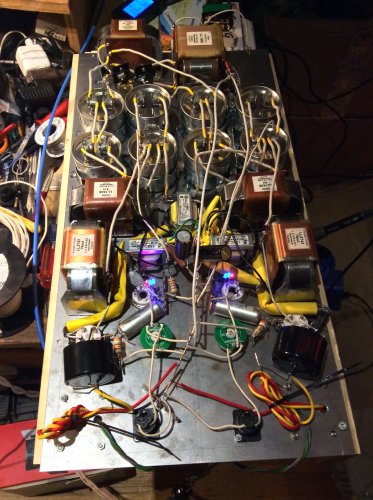So it occurred to me that my 2, long term projects, the Power Pulse paper and my HD800 research paper had been sitting there patiently waiting for me to pick them up and resume editing and then posting them.
So here is Part 1 of the power cable research paper.
And here is the 1st post of this series, just in case you want to catch up…
Part A Why Would I Want To Do This In The First Place?
https://www.head-fi.org/threads/the-diyrs-cookbook.781268/page-85#post-14294952
Why DO power cables and such make ANY difference to our headphone gear?
Yet another experiment focusing on power delivery and some not generally understood factors to consider.
Part A Why Would I Want To Do This In The First Place?
Part 1 Theory and Expectations Based Upon My Initial Research
Part 2 Measured Results and Observations.
Part 3 Analysis and Conclusions.
Part 1 Theory and Expectations Based Upon My Initial Research
So during my research on power delivery, including the nature of fuses and the ASCC tests, I noticed a correlation between a few details that are shared between them.
Later I focused in on those factors and then went digging even deeper and this paper is the result.
At that point it was a research project, just me trying to see in more detail, the nature of these relationships and how that related to our audio gear.
One of the consequences of this research was when I posted the results of my
ASSC (Available Short Circuit Current) tests, where I mentioned that there were ways of rating fuses dealing with how much current could be delivered in a very short amount of time.
The time chosen is 8ms for these I2T tests, and this duration is significant for one very good reason.
That being, it represents 1/2 of the 60 cycle frequency we use for our power delivery, in terms of time.
The 60Hz frequency our (US) power is based upon, takes 16.66 ms to complete one cycle, so half a cycle takes 8.33ms.
One half a cycle represents the 60Hz wave form completing only a positive, or a negative voltage sweep, from zero volts to the maximum voltage (120/2 = 60 volts rms) then back to zero volts.
So there is an ≈8ms positive voltage window followed by another ≈8ms voltage window (negative).
This is also why the
ASSC test uses 8ms because it establishes how much current will trip the breaker (or fuse) in just one voltage sweep from start to finish.
IOW one task of the fuse is to be able to stop the flow of current into the ‘protected’ downstream device in just one voltage sweep, in ≈ 8ms.
Now, in that ≈ 8ms window, the voltage reaches max volts at ≈ 4ms, since the sine wave is a symmetric periodic waveform.
But we actually don’t, and can’t get, current delivery for all of that 8ms window.
Why?
Well, no current will flow when the voltage is zero or is ‘too low’, for one thing, but that really isn’t the major reason.
Once the power supply is turned on and stabilizes, it has a ‘reserve’ voltage which is at a lower potential (voltage) than what the peak ac voltage that feeds the diodes, that switch on and off, that allows current to flow to the rest of the downstream power supply.
This in turn means current will only flow from the ac power source when its voltage is greater than what the ‘reserve’ voltage is, at any given time.
But as the ‘reserve’ voltage fills up after the diodes switch on, and current is delivered to ‘top off’ the ’reserve’ voltage, the diodes then turn off the flow of current as the voltage in the reserve reaches its peak voltage AND as the 60Hz wave form starts to fall off after reaching its peak voltage, after that ≈ 4ms mark.
Put another way, current will only flow into the downstream power supply when the ac voltage swing is near it’s peak (60Vrms) voltage.
And since the voltage that the ‘reserve’ has, at the start and end of this less than ≈ 8ms current delivery window, varies, this changes the start and end voltage that triggers the diodes to switch on (pass current) and off (to stop passing current).
IOW as the reserve fills up, its’s voltage rises and the diodes shut off at a higher voltage than when they switched on.
This makes the current delivery asymmetric with regards to the 60Hz (symmetric) sine wave that is feeding the power supply.
This too, is an expected result for the need of current (power) but with a limited amount of time to deliver that power.
Which in turn means the power comes into the downstream storage / filtering / regulation portion of the power supply in pulses, a series of ongoing pulses followed by corresponding ‘off’ times, followed by another ‘on’ pulse of current, and so on.
So as a consequence of this research, I figured that I would see current flow in ≈ 1/2 of that ≈ 8ms window, and peak current flow in ≈ 1/2 of that.
And as it turns out I wasn’t that far off.
Instead of the guesstimate of ≈ 4ms for the total turn on time, it measures out at ≈ 3+ms.
And that peak current flow window is ≈ 1+ms and not ≈ 2ms as I guesstimated.
And since I was motivated to pursue this line of investigation, I obtained a Tek 468 O’Scope (w/the digital capture option) and an Aim iprober 520 contact current probe, and more importantly, a plan to see where all of this would lead me.
End Part 1
Next up Part 2
Measured Results and Observations.
JJ



































 ) has moved into Phase II as a smaller step down xfmr is inbound.
) has moved into Phase II as a smaller step down xfmr is inbound.



